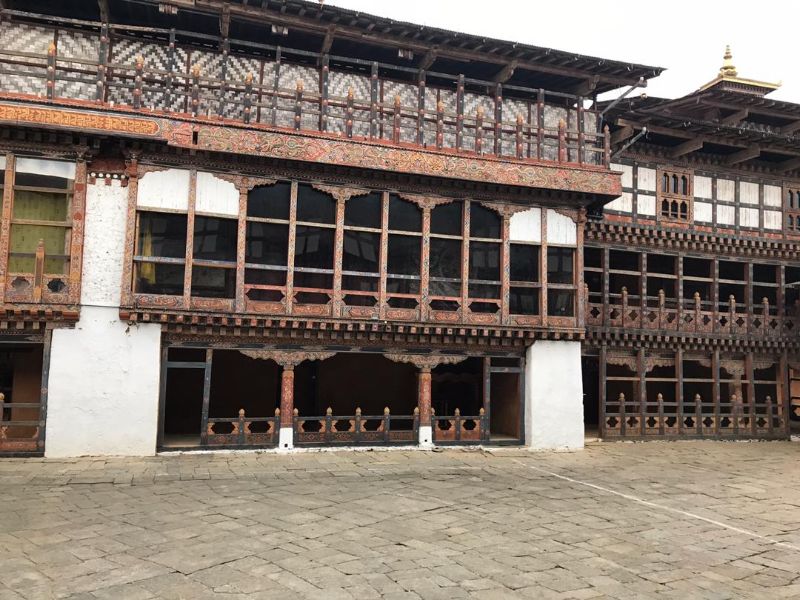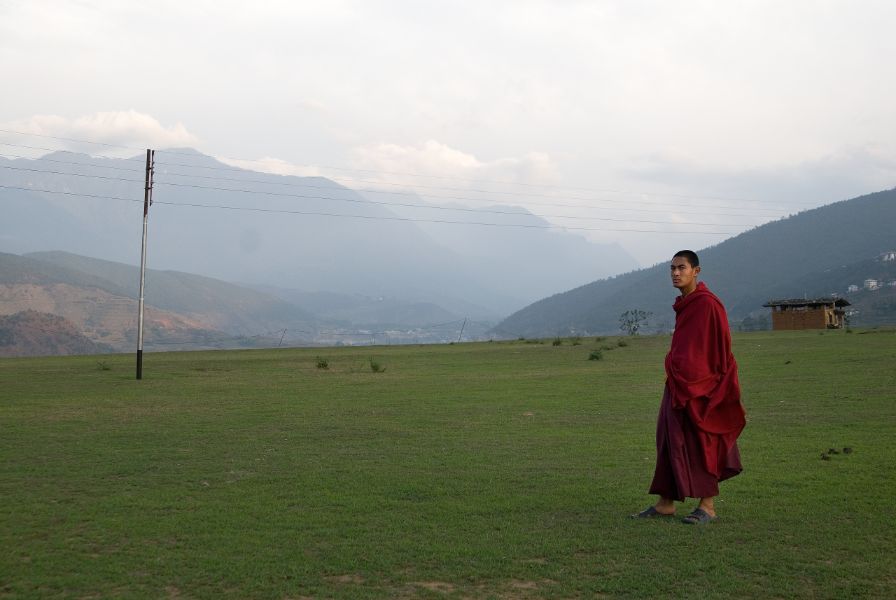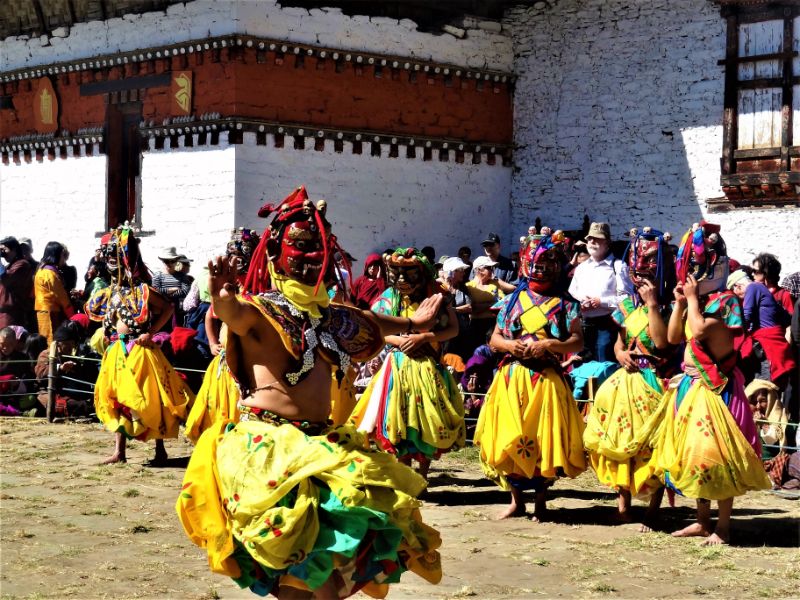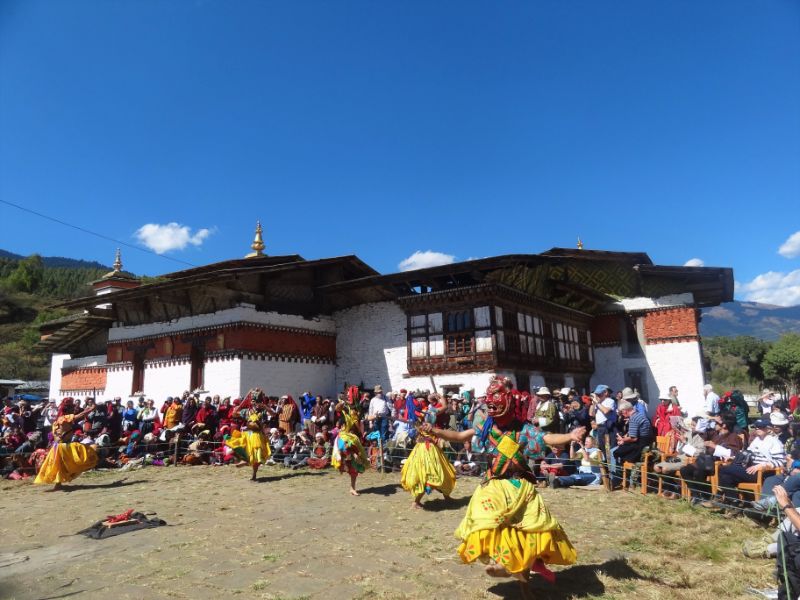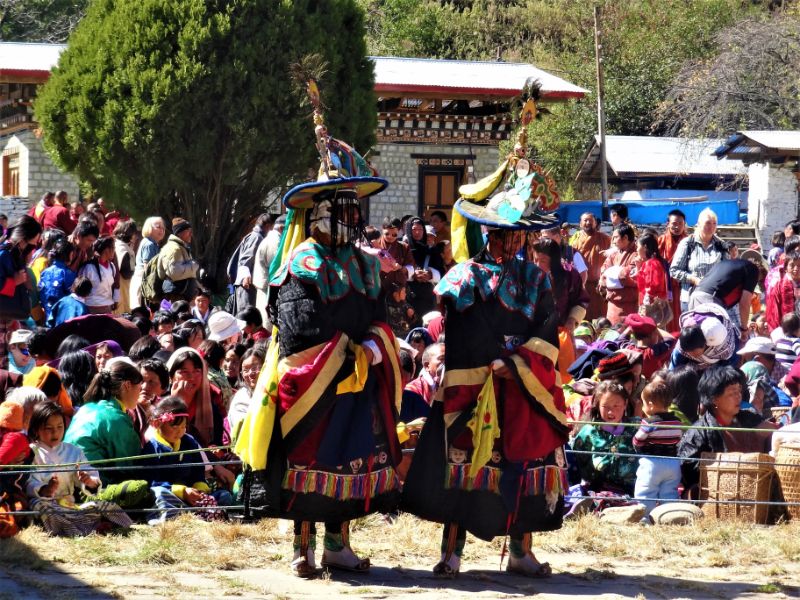Jambay lhakhang Drub
Jambay Lhakhang Drup or Jambay Lhakhang festival is an enthralling festival of Bhutan. The festival is held at Jambay Lhakhang which is one of the oldest temples in BhutanThe fire offering and the naked dance topping the list. Both of these programmes are held at night on full moon day. The locals believe that passing through the Fire offering in the form of an arch will burn away all the obstacles.
The naked dance represents the primordial wisdom of awareness and emptiness which was initiated by Terton Dorji Lingpa. Simply watching the naked dance is supposed to empower one with an ability to overcome the obstacle of anxiety and fear. Jambay Lhakhang festival also consists of other dances like Dance of Four Groups of Garudas, Stick Dance, the drum dance of Dorji Lingpa, Dance of Lord of Death, Dance of Dramitse and many other colorful and unique dances.
In this 10 Days Tour, you will also be visiting other beautiful destinations like, Thimphu-Punakha- Gangtey & Paro and doing some Bhutan cultural sightseeing.
![]() Duration: 9 Nights/ 10 Days
Duration: 9 Nights/ 10 Days
![]() Location:Thimphu-Punakha- Bumthang- Gangtey- Paro
Location:Thimphu-Punakha- Bumthang- Gangtey- Paro
Day 1: Paro – Thimphu / Thimphu Sightseeing.
Paro to Thimphu
Distance -55 Km, Time required: Approximately 1 and half hour drive.
Elevation at Thimphu: 2334mts.
After visa formalities at the Paro airport, your guide will meet you and drive you into town for lunch. Afterward, later drive to Thimphu, on the way stop by TachhogLhakhang.
Visit Simtokha Dzong. This is the first ever fort to be built in Bhutan the capital of Bhutan. It is believed to have been built over the demoness that is buried beneath the fort where it now stands. It was built in the year 1629 by the Shabdrung Ngawang Namgyel. Later drive to Kuensel Phodrang, called as Buddha Point, where you will be visiting the World’s tallest sitting Buddha Statue which is just 10 minutes drive from here.
Evening you can stroll at Thimphu town and pick up some souvenir from Craft Bazaar
The rest of the day is at leisure to unwind and absorb the beauty of this isolated kingdom.
Overnight at hotel in Thimphu
Day 2: Thimphu Sightseeing
Today, following breakfast at the hotel, you will enjoy a full day guided tour of the capital city. The morning tour includes a visit to National Library, which houses an extensive collection of Buddhist literature, with some works dating back several hundred years. Visit the nearby Institute for Zorig Chusum (commonly known as the Painting School), where a Six-year training course is given in the 13 Traditional Arts and Crafts of Bhutan.
After lunch proceed to your next sightseeing points. It includes National Memorial Chorten. The building of this landmark was originally envisaged by Bhutan’s third king, His Majesty Jigme Dorji Wangchuck (“the father of modern Bhutan”) who wanted to erect a monument in honour of world peace and prosperity. Completed in 1974 after his untimely death, monument, serves both as a memorial to the Late King and as a monument to peace.
Your next spot is the Jungshi Handmade paper factory where you will witness the Traditional paper making methods. You can watch the workers boil, soak, and clean before pounding them into a pulp and swirling them on to a bamboo screen to dry.
On your way back visit the Centennial Farmers Market. The farmers from in and around Thimphu come here with their local produce for sell. It has an interesting mixture of Vegetables stall and Rice stall.Different variety of Rice and Vegetables are brought here for sale.
Later in the evening visit the Fort (Tashichoedzong) or the fortress of the Glorious Religion, the beautiful medieval fortress which houses most of the Government’s office and King’s Throne room. It is also the summer residence of Je Khenpo, the Chief Abbot.
Overnight at hotel in Thimphu
Day 3: Thimphu – Punakha / Punakha Sightseeing.
Thimphu to Punakha
Distance -71 km, Time required: around 2 Hrs and 30 minutes.
Elevation at Punakha: 1200 meters
Following breakfast at the hotel, drive up to Dochu La (3,088m/ 10,130 ft) stopping briefly here to take in the view and admire the chorten, Mani wall, and prayer flags which decorate the highest point on the road. If skies are clear, the following peaks can be seen form this pass ( left to right) : Masagang(7,158m), Tsendegang (6,960m), Terigang (7,060m), Jejegangphugang (7,158m), Kangphugang (7,170m), Zongphugang (7,060m), a table mountain that dominates the isolated region of Lunana – finally Gangkar Puensum,the highest peak in Bhutan at 7,497m.
Later proceed for sightseeing; it includes the hike to the famous “Chimi Lhakhang “called as “TEMPLE OF FERTILITY”. The hike is mild and it takes you through the valley of Sopsokha and its beautiful terraced paddy fields before reaching the spot.
Later on your way back have lunch at the cafeteria. Spend about an hour before proceeding to Punakha.
Check in your hotel and later visit to Punakha Dzong, the 17th century fortress which has played important role in building up of modern Bhutan followed by visit to local market.
If time permits we can hike to Khamsum Yulley Namgyal Chorten. The view of the valley and the soaring mountains is spectacular.
Overnight at the hotel in Punakha
Day 4: Punakha- Bumthang Via Trongsa
Punakha to Bumthang
Elevation at Bumthang: 2,650 meters
Distance: 200kms
Time required: 7 hours and 30 minutes – 8 hours.
After a good breakfast begin your journey towards Bumthang. 30 minutes drive from Punakha will reach you at the Pele La Pass (3,420m/11,220ft) where you will get good views of the snow capped mountains and you will also have a chance of seeing the Mt. Jumolhari during fine weather condition.
Drive for another one hour and make a short stop at the Chendebji resort for a tea. You will come across a monument resembling to the Swayambhunath in Kathmandu, Nepal called as Chendebji Chorten. Again drive for another one and half hour and it will reach you at Trongsa (2.200m/7,215ft). On arrival in Trongsa visit the fort of Trongsa. It is the largest fort in Bhutan. It is from here that the present royal family emerged as the most powerful force at the beginning of this century.
After your lunch and a short rest drive towards Bumthang for three hours across the Yotong La (Pass) which lies at 11,269ft, then descend into Chumey valley, the first of the four Bumthang valleys. Bumthang valley is considered as one of the most sacred and holiest in the kingdom. It is here that the past kings were cremated.
Overnight at the hotel in Bumthang
Day 5: Witness Jambay Lhakhang Drub
After breakfast drive to the Jambay Lhakhang, the venue for the festival. You will witness the full second day for the Jambay Lhakhang Drub which commences around 10:30 am.
Many ritual dances will be performed in the courtyard. It is a 5 day event.
On First Day the program is intended to give moral instruction; 2. Designed to chase away the evil spirits and 3.To celebrate the Buddhist faith. This is also an opportunity for the local businessmen to bring their goods and sell. There will be stalls selling crafts work, jewellery, religious artifacts and thangkas.
On Second day they have dance of Black Hat/Dance of Four Ging Dance of offering /Fire Dance/Dance of lord of cremation ground and at midnight it will be followed by Ter cham; Ter-Cham or Sacred Naked Dance which is the main highlight of the festival. Exactly at midnight, a group of men rush out from the door, swirling and twirling in air, to the rhythmic accompaniment of traditional mask dance drums and cymbals. They are known as sacred naked dancers or Ter Cham of Jambay Lhakhang. The third, fourth and fifth day is also followed by similar mask dances and other dances like Dance of Heroes, Dance of Four Stags & famous drum dance of Drametse
Overnight at hotel in Bumthang
Day 6: Discover Fascinating Bumthang Valley
Discover the fascinating spiritual valley, home to some of the ancient temples and monasteries of the kingdom. The valley is also known for its production of honey, cheese, apple and woolen materials called yathra.
Start your day by visiting the auspicious Kurje Lhakhang named after the body imprint left by Guru Rinpoche on a rock and learn about the exciting legends and myths connected to the place. Following the tarmac road to the south takes you to the ancient Jambay Lhakhang dating back to the 7th century.
Uncover the stories and mysteries linked with the construction at Tamzhing Lhakhang before setting out into the wild explore the Tang Mebar Tsho.
Overnight at hotel in Bumthang
Day 7: Bumthang – Gangtey
Distance: 188 km
Time required: 5-6 hours
Elevation at Wangdue: 1300m
After your morning breakfast check out from the hotel and drive back towards Wangdue. On arriving Trongsa visit the Tower of Trongsa a watch tower before which is now converted to a Museum. Have lunch at the Cafeteria at The Museum. Get some rest after your lunch and continue with your journey towards Gangtey. Make a short stop at Chendebji Resort for a tea break. Again after your tea break, set out to the beautiful alpine valley of Phobjikha. Observe the vegetation change as you drive to Phobjikha.
The valley is popular for its scenic splendor and cultural uniqueness. Phobjikha is well known as the winter home of the Black-Necked Cranes (Grus Nigricollis) that migrate from the Tibetan plateau. The birds can be observed from early November to end of March.
Upon arrival to Phobjikha valley visit 17th century Gangtey Monastery overlooking the gorgeous Phobjikha Valley. Take pictures of the monks with the exquisite carving and sculpture of the monastery.
Visit the Crane Information Center, if time permits. Rest of the evening enjoy the mystic tranquil environment of Phobjikha valley
Overnight at hotel in Phobjikha
Day 8: Gangtey – Paro
Gangtey – Paro
Distance: 124 km
Time required: 4 hours 30 minutes – 5 hours
Elevation at Paro: 2,200m
In the morning explore Gangtey valley
The most beautiful and shortest of the existing nature trails in Bhutan. The trail hike starts from the Mani (like Chorten) stone wall to the north of the Gangtey Gonpa and ends in Khewa Lhakhang. The hike takes about 1hr 30minutes through the pine forest and small bamboo plants. You can see the Phobjikha valley/Gangtey valley so beautifully from this hike. It is one of the best hike places for the Nature lovers. During the winter months, we can see the endangered species of birds – Black Neck Cranes.
Begin your journey towards Paro after the hike.
The journey will take you about four hours to five hours. Make a stop at the Dochu La Pass (3140m) for your lunch while you can enjoy the magnificent view of the eastern Himalayan ranges. After your lunch break resume your journey to Paro.
On your arrival drive to the National Museum of Paro, once a watchtower, built to defend Rinpung Dzong during inter valley wars of the 17th century, Ta Dzong was inaugurated as Bhutan’s National Museum in 1968. It holds fascinating collection of Arts, relics, religious Thangka paintings and Bhutan’s exquisite postage stamps and later visit the Paro Rinpung Dzong meaning the fortress on the heap of jewels or the fort of Paro.
Overnight at the hotel in Paro
Day 9: The Famous Tiger’s Nest Hike
Today you will be hiking to one of the famous site called as the Tiger’s Nest (Taktshang) perched at 900m above the Paro valley.
It is a pilgrimage site which the Bhutanese try to visit at least once in a lifetime. It is believed that Guru Rinpochhoe flew on the back of a tigress from eastern Bhutan to this site and meditated in a cave here for 3 months, hence its name, ‘Tiger’s Nest’. The site, which has long been regarded as the sacred place, was visited by Shabdrung Ngawang Namgyel in the 17th century approximately in 1646. The Lhakhang of the present monastic complex dates from 1692. The main structure was severely damaged by fire in 1998, but with the help of the local people and the government it has been put back to its glory.
The hike can be broken down into various stages.
The first stage is the trek to the cafeteria (where lunch will be served later today) which is situated on a rocky outcrop across a ravine from the monastery. This leg of the trek takes approximately 45 minutes to 60 minutes, depending on your level of fitness. At the Cafeteria we can stop for some tea or coffee and biscuits whilst pondering the journey ahead and looking at the monastery I the distance above us.
The 2nd stage of the walk is from the cafeteria to the lookout opposite of the monastery. This leg takes close to one hour..
The next stage is the trek/climb down the 475 steps in the cliff face to the bottom of the ravine which crosses over a stream and a waterfall before the path again ascends another 300 odd steps to the entrance of the monastery. Once here we should be able to enter into the monastery and view the cave where Guru Rinpoche meditated. (Cameras are not allowed inside the monastery).
On your way back visit the Kichu monastery. It is the one of the oldest and the first ever Buddhist monastery to be built in Bhutan. It was built in the 8th century.
Overnight at the hotel in Paro
Day 10: Departure
Our team will drop you to the airport and bid you farewell.
Festival Date
28th – 31st October, 2023
TOUR HIGHLIGHTS
PACKAGE COST FROM
$ 2560
Package cost :
USD 2560 per Person basis on double sharing basis
Single Room Supplement:
USD 40 per Person and per Night
PACKAGE INCLUSION
Sustainable Development Fee to the Government of Bhutan which goes towards the development of schools. hospitals. etc.,
Bhutan Visa
Accommodations in 3- star properties. (Can be upgraded to 4 & 5-star with additional Premium)
All Meals (Breakfast, Lunch & Dinner)
Certified English Speaking Bhutanese Guide.
All ground transportation
All internal taxes and charges including Entry Fees
Mineral Water while traveling
Complimentary from company:
Traditional Hot Stone Bath
PACKAGE EXCLUSION
Airfare (can be arranged with us)
Travel Insurance
Any Expenses of Personal Nature
Tips for the guide and driver


